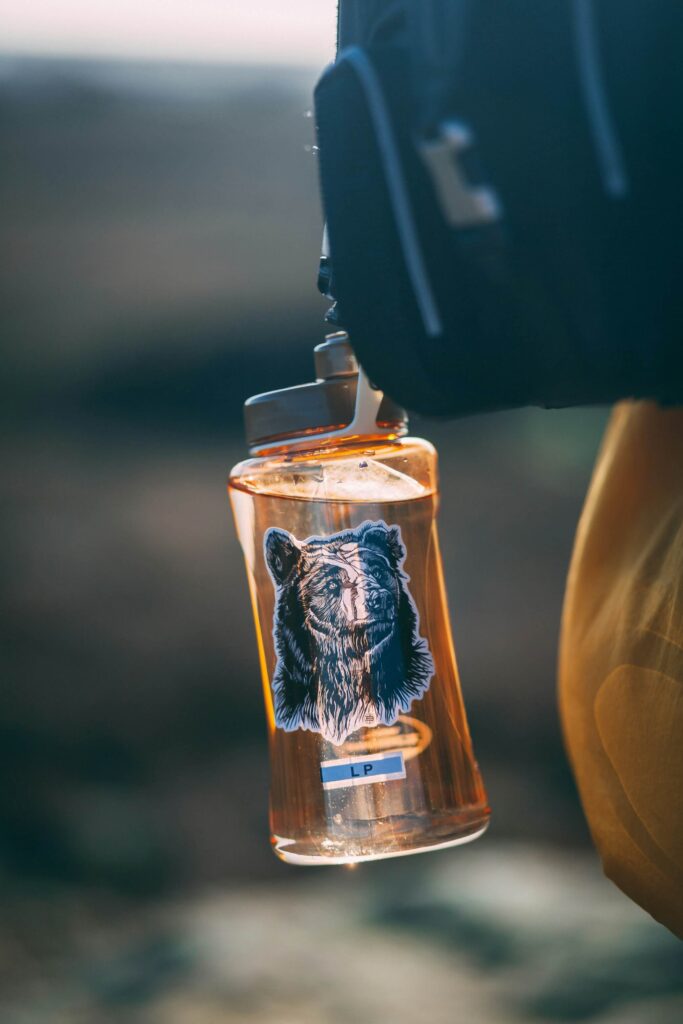We’ve all been there: carefully curating a collection of stickers on our favorite water bottles only to watch them peel away after a few washes. It’s frustrating to see our personalized designs fade and fall apart. But don’t worry, there are effective ways to keep those stickers intact and looking fresh.
Understanding Sticker Issues
Water bottles undergo frequent washing, making sticker durability a key concern. Different materials react differently to water, detergents, and abrasion. Knowing the factors that contribute to sticker deterioration helps in choosing and maintaining higher-quality stickers.
Material Quality
Sticker material quality varies significantly. Vinyl stickers usually resist water, whereas paper-based stickers often fade and peel. Plastics and laminates provide a robust defense against moisture, keeping designs intact.
Adhesive Properties
Adhesive strength impacts sticker longevity. Strong adhesives bond firmly, but low-quality ones might loosen after repeated washes. We should select stickers specifically labeled as water-resistant for maximum adherence.
Environmental Factors
Exposure to sunlight, heat, and moisture further affects sticker conditions. UV rays can fade colors, and heat can weaken adhesive. Opting for UV-protected and heat-resistant stickers can mitigate these effects.
Washing Methods
Hand washing versus dishwashing presents different challenges. While hand washing allows control and gentleness, dishwashers expose stickers to high temperatures and harsh detergents. Washing bottles by hand, using mild soaps, prolongs sticker life.
Bottle Surface
Sticker adhesion also depends on the surface of the bottle. Smooth, clean surfaces provide a better grip, whereas textured or oily surfaces decrease adhesion. Cleaning the surface thoroughly before applying stickers ensures a stronger bond.
By understanding these factors, we gain insights into preserving sticker quality on water bottles. This knowledge equips us to make informed decisions on sticker selection and maintenance.
Choosing The Right Stickers
Selecting the right stickers can significantly impact their durability, especially through repeated washing.

Waterproof Vinyl Stickers
Waterproof vinyl stickers excel in high-moisture environments. They resist water damage, ensuring your designs stay vibrant. These stickers use durable plastics, which makes them ideal for water bottles. Since they’re scratch-resistant, they maintain their appearance despite daily wear and tear. For best results, clean and dry the bottle surface completely before applying vinyl stickers.
Weatherproof Labels
Weatherproof labels offer protection against various environmental factors. They resist not only water but also UV rays and temperature fluctuations. This resilience prevents fading and peeling, extending the sticker’s lifespan. Made from robust materials, these labels stay intact even under challenging conditions. To enhance adhesion, ensure the bottle surface is free of oil and dirt before application.
Proper Application Techniques
Ensuring stickers stay on water bottles involves the right application methods. Follow these steps to maximize sticker durability.
Cleaning The Surface
Clean the surface thoroughly before applying stickers. Dirt, oil, and residue can weaken adhesion. Use mild soap and water, then dry the bottle completely. For added assurance, wipe it with rubbing alcohol to remove any remaining oils.
Applying Stickers Smoothly
Apply stickers smoothly to avoid air bubbles and wrinkles. Peel the backing paper partially, align the sticker’s edge with the chosen spot, and press gently. Gradually peel off more backing paper while smoothing the sticker down with a straight edge like a credit card. This method secures a firm, bubble-free application, enhancing the sticker’s durability.
Sealing The Stickers
To prevent stickers from washing off water bottles, applying a sealant can help protect them. Several methods can be used to ensure the stickers remain intact and vibrant. Here are some effective sealing techniques:
Using Mod Podge
Mod Podge seals stickers on water bottles by providing a protective coating. First, clean the surface of the bottle thoroughly to remove any dirt or oil. Apply a thin layer of Mod Podge using a foam brush over the sticker, ensuring even coverage. Let it dry for at least 15 minutes, then add another layer. For optimal protection, apply 2-3 coats, letting each layer dry completely before adding the next. This method creates a durable barrier against water and wear.
Applying Clear Nail Polish
Clear nail polish offers a quick and easy way to seal stickers. Ensure the bottle surface is clean before application. Brush a thin layer of clear nail polish over the sticker, covering its entire surface. Allow it to dry completely, which usually takes 10-15 minutes. For extra durability, consider adding a second coat once the first is dry. This sealant is particularly effective for small stickers or intricate designs.
Laminating Stickers
Laminating stickers before applying them provides robust protection. Use self-adhesive laminating sheets readily available at office supply stores. Cut the laminating sheet to slightly larger than the sticker’s size. Place the sticker on the adhesive side of the laminating sheet, then press firmly to ensure no air bubbles form. Trim the excess laminate, leaving a small border around the sticker. Apply the laminated sticker to your clean, dry water bottle surface for long-lasting protection.
By understanding these sealing techniques, we can effectively preserve our sticker designs on water bottles and enjoy their appearance for a much longer time.
Maintenance Tips
Proper maintenance can significantly extend the life of stickers on water bottles and keep them looking fresh. Implementing these tips ensures maximum durability and adhesion.
Hand Washing Tips
Hand washing bottles with stickers is essential to prevent peeling or fading. Using mild soap and lukewarm water, gently scrub the bottle’s surface with a soft cloth or sponge. Avoid using abrasive scrubbers or brushes since they can damage stickers. Pay attention to cleaning around the stickers without scrubbing directly on them. After washing, rinse thoroughly and allow the bottle to air dry. If necessary, lightly pat dry the areas around the stickers with a soft towel. Hand washing not only preserves sticker designs but also maintains the overall quality of the bottle.
Avoiding Dishwashers
Dishwashers cause significant wear on stickers due to high temperatures, strong detergents, and intense water pressure. To prevent sticker damage, always opt for hand washing. Dishwashers expose bottles to prolonged moisture and heat, leading to rapid adhesive breakdown and color fading. If using a dishwasher is necessary, place the bottle on the upper rack where the heat and water pressure are less intense. However, hand washing remains the safest method to preserve sticker integrity and ensure long-lasting beauty.
Using these maintenance tips, we can keep our stickers looking vibrant and securely attached, enhancing the personalization of our water bottles.
Conclusion
By carefully selecting water-resistant stickers and applying them to clean smooth surfaces we can significantly enhance their durability. Hand washing with mild soap and lukewarm water helps maintain the integrity of both the stickers and the bottle. Sealing techniques like Mod Podge or clear nail polish provide an extra layer of protection ensuring our designs stay vibrant and intact. With these methods we can enjoy our personalized water bottles without worrying about stickers peeling or fading. Let’s keep our bottles looking fresh and unique for longer.
Frequently Asked Questions
A standard 32oz water bottle typically holds about 1 liter of liquid (32 fluid ounces), making it a popular size for outdoor activities. The dimensions vary by brand, but most 32oz bottles are approximately 9 to 10 inches (22 to 25 cm) tall and have a diameter of 3 to 3.5 inches (7.5 to 9 cm). This size is ideal for staying hydrated during hikes, workouts, or daily use.
Most standard stickers will not survive the heat and moisture of a dishwasher. To ensure your stickers last longer, it’s best to hand wash your water bottles. However, if you’re using waterproof or vinyl stickers, they may have better durability in the dishwasher, but even these are safer with handwashing.
To protect stickers, make sure to clean and dry the surface of your water bottle before applying them. Consider using a clear waterproof sealant spray, or cover the stickers with a protective layer of transparent vinyl or tape to shield them from water and wear.
Yes, vinyl stickers tend to last longer than regular paper stickers because they are water-resistant and more durable. Vinyl is also less likely to fade, peel, or tear, making it a better choice for outdoor use and frequent washing.
To make stickers more waterproof, you can apply a clear sealant like Mod Podge or a spray-on waterproof coating. Another option is to laminate the sticker or apply clear vinyl over the top to create a water-resistant barrier.
While some stickers are designed to be removable and repositionable, most will lose their adhesive once removed. To reapply a sticker, you can use a spray adhesive or sticker glue, but it may not hold up as well as the original application.
Stickers may peel off due to moisture exposure, uneven surfaces, or improper application. Make sure the surface is clean and dry before applying stickers, and avoid placing them on curved or textured areas where they won’t adhere well. Using a sealant can also help prevent peeling.
Yes, Lost Canyon Threads stickers are designed to withstand outdoor use and are made with durable materials. However, to maximize their lifespan, we recommend handwashing your water bottles and avoiding the dishwasher.
The safest way to clean a water bottle with stickers is to hand wash it with mild soap and warm water. Avoid soaking the sticker areas directly, and use a soft sponge or cloth instead of abrasive materials that could scratch or peel the stickers.
Yes, you can apply stickers to insulated water bottles like those made from stainless steel. Just make sure the surface is smooth, clean, and dry before applying the stickers. For added protection, consider using a clear coating to seal them in.
If your sticker starts peeling or showing signs of wear, you can apply a clear sealant to extend its life. If the damage is significant, it may be best to replace the sticker with a new one. Consider using vinyl or waterproof stickers for better durability in the future.


